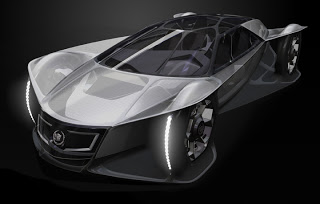The Los Angeles auto show has a one thousand pound car design competition. The objective is to envision an efficient, light-weight, four passenger vehicle (not to exceed 1,000 lbs.), that is both comfortable and safe, while delivering satisfactory driving performance without sacrificing the styling consumers demand. For the first time studios from Germany and Japan will join the competition adding an international dimension to the contest. This is an important competition because recently the Edison2 car won the 100 mpg xprize car competition with a four passenger car that weighs about 700 pounds. Lighter cars can get better gas mileage. The competing entries look fantastic.
General Motors New Cadillac Aera Design
The Cadillac Aera (Aero + Era) launches Cadillac’s philosophy of “Art and Science” into new territory by taking an innovative and stylistic approach to ultra-light weight vehicle design. Aera is a 1000 lb, 2+2 touring coupe, with a range of 1000 miles before refueling; attributes achieved without compromising size, capacity and safety.
Optimum efficiency, minimum parts
Aera’s highly advanced body structure utilizes a 3D lattice, mono-formed frame. This polyhedral structure is similar to configurations found consistently in nature, e.g., inside the grouping of bubbles. The structure is formed from unique, alloy-utilizing, semi-solid freeform manufacturing, creating a naturally strong, extremely lightweight frame. All major body parts, including interior components, are essentially “grown” into a single part lattice structure.
Renowned Cadillac smoothness and quietness are accomplished using the harnessed power of compressed air via a highly efficient Pneumatic Drive System (PDS). Its 10,000 psi composite air storage tank has ample capacity for a 1000 mile range. Flexible, pressurized air cells in the exterior skin, similar to material developed for the NASA Mars Rover airbags, enhance passive safety and interior comfort. The flexible polymer skin optimizes aerodynamics and functions as an ultra-lightweight alternative to conventional body panels and glass.
Additional technologies include an All-In-One (AIO) wheel system, combining rotary actuator propulsion, steering and suspension functions. A drive by wireless system decreases the mass of electrical components. Vehicle to vehicle communication (V2V) promotes active safety.
Honda Air
The Honda Air concept is a vision of the future of lightweight and alternative fuel performance vehicles; a coastal cruiser for the aggressive lifestyle. Inspired by the modern roller coaster as well as skydiving wing-suits, the Air is powered by a compressed air and pneumatic regulator system. It utilizes turbo vacuums and external air-flow to regenerate tank pressure for extended range and increased boost for an estimated 100 miles. The chassis doubles as the master tank and all components, including seating, are mounted to the central chassis/tank to eliminate redundant structure and reduce overall weight.
Vegetable based polymer panels and fairings protect occupants, maintaining the solid Honda method; safety for everyone. The Air’s cockpit and package maintain the aggressive human packaging of a modern roller coaster aimed at maximizing the open air experience. In order to reduce weight and increase dynamic performance, a hub-less wheel and drive system eliminates the use of heavy drive train components. Glass reinforced seating panels, urethane tire composition and skeletal sub-frame components combine for drastic weight savings. Using a Honda generator / air compressor at home or tire filler at your local filling station, the main tanks and reserves can be filled quickly and safely.
At just under 800 lbs., the powerful anthem of pneumatic propulsion and a character unlike any zero-emission vehicle exemplifies Honda’s concept of fun to drive.
Nissan iV
Nissan iV is a high-performance EV (Electric Vehicle) inspired by nature’s intelligent beauty and crafted by human ingenuity. The iV is a super-lightweight sports tourer that showcases “organic synthetics,” a revolutionary manufacturing technique in which automotive parts are cultivated like agriculture in a 100% sustainable, carbon-neutral process.
Every detail of the Nissan iV is engineered toward renewable, lightweight strength and maximum efficiency. Featuring an interwoven organic frame, iV’s chassis material is synthetically grown and formed into a stunning, aerodynamic shape. Derived from fast-growing ivy and re-enforced with spider silk composite, the biopolymer frame is flexible and ultra-light, yet extremely robust. The spacious, panoramic cabin comfortably seats four adults and is constructed from an innovative photovoltaic material that weighs 99% less than traditional glass. While the canopy collects solar energy, it also provides protective safety and unique, open-air views of the outdoors. Underneath it all, a slim bio-battery provides stability and a near limit-less range made possible by regenerative super-capacitor technology that recoups 60% of kinetic energy spent.
Nissan’s patented concentric hub-less in-wheel motors not only propel iV, they do triple-duty by functioning as the vehicle’s steering as well as its suspension system, via magnetic levitation and propulsion. Concentric magnetic rings amplify rotation with each outer ring to boost high-speed performance and provide independent wheel control for ultimate handling and maneuverability. Inspired by schools of fish and their fluid movement, Nissan’s pro-active Safety Shield™ renders collisions a thing of the past and reduces weight by eliminating the need for heavy structures (bumpers, beams, airbags, etc.).
If you liked this article, please give it a quick review on ycombinator, or Reddit, or StumbleUpon. Thanks
Featured articles
Ocean Floor Gold and Copper
Ocean Floor Mining Company
Thank You

Brian Wang is a Futurist Thought Leader and a popular Science blogger with 1 million readers per month. His blog Nextbigfuture.com is ranked #1 Science News Blog. It covers many disruptive technology and trends including Space, Robotics, Artificial Intelligence, Medicine, Anti-aging Biotechnology, and Nanotechnology.
Known for identifying cutting edge technologies, he is currently a Co-Founder of a startup and fundraiser for high potential early-stage companies. He is the Head of Research for Allocations for deep technology investments and an Angel Investor at Space Angels.
A frequent speaker at corporations, he has been a TEDx speaker, a Singularity University speaker and guest at numerous interviews for radio and podcasts. He is open to public speaking and advising engagements.





1 thought on “One Thousand Pound Los Angeles Car Design Competition Part 1 GM Aera, Honda Air and Nissan iV”
Comments are closed.